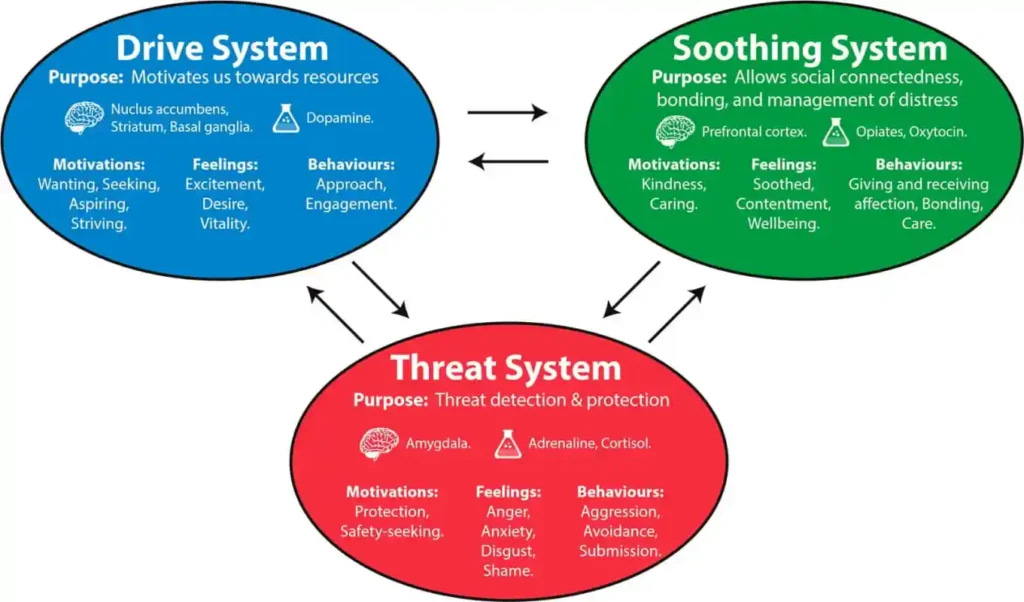#125 | 🧠 Threat, Drive, and Soothe: The Psychology Behind How You Push Yourself
A collection of the best hidden gems, mental models, and frameworks from the world’s top thinkers; to help you become 1% better and live a happier life ❤️
Hello curious minds 🧠
My therapist shared with me this framework that I found to be a very powerful way of understanding how our inner systems work. When introduced by it, I decided to dig deeper using AI Deep Research cause that’s the “better” way of doing things these day, right? ;)
The framework is called the Threat, Drive, and Soothe systems.

This framework, developed by Paul Gilbert, helps us better understand how our emotional systems work together to shape our psychological balance. The idea is that we are constantly switching between these three systems (threat, drive, and soothe) to manage our emotions. Research shows that many mental health difficulties come from overactive threat responses and underdeveloped soothing methods.
Here’s a quick rundown of the three emotional regulation systems:
🚨 Threat (survival mode) - keeps you alert to dangers (real or imagined). The associated feelings include anxiety, anger, disgust, embarrassment, etc. The Threat system keeps you “on guard” or under pressure.
🏆 Drive (achievement mode) - pushes you toward success and goals. The associated feelings include excitement, focus, wanting, and satisfaction of progress. The Drive system is reward-based, giving us the sense of accomplishment. An over-reliance on Drive can lead to burnout.
💙 Soothe (recovery mode) - helps you rest, recharge, and feel safe. The associated feelings include contentment, safety, protection, and trust. The Soothe system helps us down-regulate when feeling distressed or overwhelmed. This is the system that most people underdeveloped.
The key is balance. We need all three systems, but most of us lean too much on Threat and Drive while neglecting Soothe.
So the real question is: how often do you actually let yourself slow down and feel safe?
I don’t know.
This is something I am still figuring out.
But I do believe that just by understanding these three systems alone can be very helpful as awareness can help us see where we are stuck and what we might need to work on.
For most people, including myself, the goal is probably to shift from being driven by threat to being driven by compassion.
🚀 If you are new here…
Hi, I’m Ryan 👋🏼 I am passionate about lifestyle gamification 🎮, which it’s just a fancy way saying I approach life like a video game, designing my character intentionally, and strive to level up every day. I am obsesssssssss with learning things that can help me live a happy and fulfilling life.Every Sunday, through The Limitless Playbook newsletter, I share 1 actionable idea from the world's top thinkers 🎯
Oh, and fun fact: I am a PhD candidate in AI 👻 I am deeply interested in how AI can help us 10x the way we live, learn, and thrive; so expect me to share some cool AI tools, insights, and research 🤖
✌🏼 Moving from Threat-Based to Compassion-Based Drive
You can be driven by threat or you can be driven by compassion.
Most people lean more toward threat-based drive.
Few are driven by compassion.
It’s not so black and white. Our drive is rarely 100% one or the other. Some people might be 60% threat-driven and 40% compassion-driven, while others might experience a much more imbalanced dynamic, often leaning toward threat.
As I write this newsletter, I become more uncertain of where I lie. There’s a huge level of threat-based drive, mainly connected to my upbringing in the UK but I believe I also possess a high level of compassion-based drive. More reflection is needed here.
But what happens when you, like most people, have a bias toward threat-based drive?
When things are going well, this can seem like a non-issue. But when things don’t go according to plan (and it most likely won’t in many cases, especially if you are striving higher and higher), two issues arise (from my experience):
It’s not sustainable - in at least two ways; a) there’s an upper limit to how much certain drives can push us and b) there’s a natural limit to how long we can sustain them
It’s easy to get into a deep negative spiral - when your drive has been fueled by counteracting threats, failure doesn’t just mean falling short of a goal. It creates a “double negative”; negative from the drive and negative from the threats. This can lead to anxiety, self-doubt, or even a loss of trust in yourself.
A healthier way is to cultivate drive through compassionate reasons, rather than just using it to escape threat.
The truth is, I don’t fully know what that feels like. Or maybe I do, but my motivations have been so entangled between threat and compassion that I struggle to tell the difference. Back to writing and reflection.
I am always curious about what others are passionate about and what they are currently working on. Hit reply and share what’s been keeping you busy these days. I would love to learn!
With love,
Ryan O. 🎮
😈 Connect with me on:
🎬 YouTube, 🐦 Twitter, 👨🏻💻 LinkedIn, 🌍 Personal Website, and 📸 Instagram




